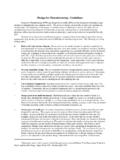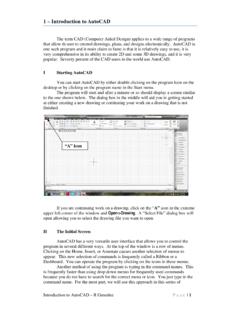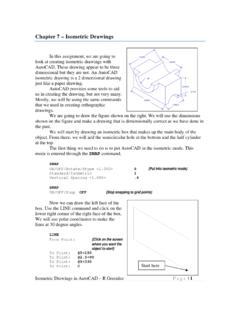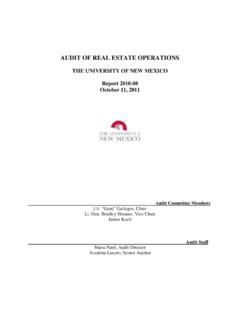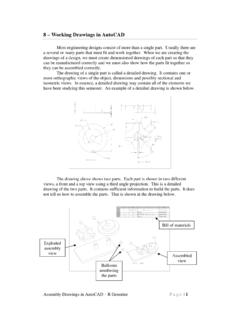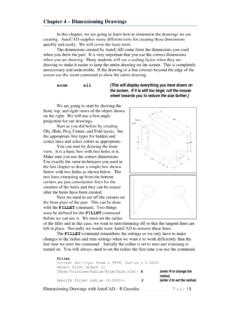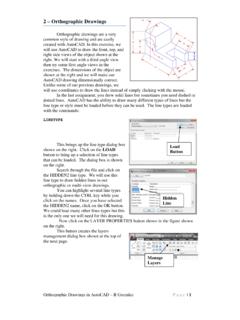Transcription of Step'by-step guide to critiquing research. Part 1 ...
1 Step'by-step guide to critiquingresearch. part 1: quantitative researchMichaei Coughian, Patricia Cronin, Frances RyanAbstractWhen caring for patients it is essential that nurses are using thecurrent best practice. To determine what this is, nurses must be ableto read research critically. But for many qualified and student nursesthe terminology used in research can be difficult to understandthus making critical reading even more daunting. It is imperativein nursing that care has its foundations in sound research and it isessential that all nurses have the ability to critically appraise researchto identify what is best practice. This article is a step-by step-approachto critiquing quantitative research to help nurses demystify theprocess and decode the words: quantitative researchmethodologiesReview process research ]or many qualified nurses and nursing studentsresearch is research , and it is often quite difficultto grasp what others are referring to when theydiscuss the limitations and or strengths withina research study.
2 research texts and journals refer tocritiquing the literature, critical analysis, reviewing theliterature, evaluation and appraisal of the literature whichare in essence the same thing (Bassett and Bassett, 2003).Terminology in research can be confusing for the noviceresearch reader where a term like 'random' refers to anorganized manner of selecting items or participants, and theword 'significance' is applied to a degree of chance. Thusthe aim of this article is to take a step-by-step approach tocritiquing research in an attempt to help nurses demystifythe process and decode the caring for patients it is essential that nurses areusing the current best practice. To determine what this isnurses must be able to read research . The adage 'All thatglitters is not gold' is also true in research . Not all researchis of the same quality or of a high standard and thereforenurses should not simply take research at face value simplybecause it has been published (Cullum and Droogan, 1999;Rolit and Beck, 2006).
3 critiquing is a systematic method ofMichael Coughlan, Patricia Cronin and Frances Ryan are Lecturers,School of Nursing and Midwifery, University of Dubhn, TrinityCollege, DublinAccepted for publication: March 2007appraising the strengths and limitations of a piece of researchin order to determine its credibility and/or its applicabilityto practice (Valente, 2003). Seeking only limitations in astudy is criticism and critiquing and criticism are not thesame (Burns and Grove, 1997). A critique is an impersonalevaluation of the strengths and limitations of the researchbeing reviewed and should not be seen as a disparagementof the researchers ability. Neither should it be regarded asa jousting match between the researcher and the and Grove (1999) call this an 'intellectual critique'in that it is not the creator but the creation that is beingevaluated.
4 The reviewer maintains objectivity throughoutthe critique. No personal views are expressed by thereviewer and the strengths and/or limitations of the studyand the imphcations of these are highlighted with referenceto research texts or journals. It is also important to rememberthat research works within the realms of probability wherenothing is absolutely certain. It is therefore important torefer to the apparent strengths, limitations and findingsof a piece of research (Burns and Grove, 1997). The useof personal pronouns is also avoided in order that anappearance of objectivity can be and integrityThere are numerous tools available to help both novice andadvanced reviewers to critique research studies (Tanner,2003). These tools generally ask questions that can help thereviewer to determine the degree to which the steps in theresearch process were followed.
5 However, some steps aremore important than others and very few tools acknowledgethis. Ryan-Wenger (1992) suggests that questions in acritiquing tool can be subdivided in those that are usefulfor getting a feel for the study being presented which shecalls 'credibility variables' and those that are essential forevaluating the research process called 'integrity variables'.Credibility variables concentrate on how believable thework appears and focus on the researcher's qualifications andability to undertake and accurately present the study. Theanswers to these questions are important when critiquinga piece of research as they can offer the reader an insightinto \vhat to expect in the remainder of the , the reader should be aware that identified strengthsand limitations within this section will not necessarilycorrespond with what will be found in the rest of the questions, on the other hand, are interested in therobustness of the research method, seeking to identify howappropriately and accurately the researcher followed thesteps in the research process.
6 The answers to these questions658 British Journal of Nursing. 2007. Vol 16, No IIRESEARCH METHODOLOGIEST able 1. research questions - guidelines for critiquing a quantitative research studyElements influencing the beiievabiiity of the researchElementsWriting styieAuthorReport titieAbstractQuestionsIs the report well written - concise, grammatically correct, avoid the use of jargon? Is it weil iaid out andorganized?Do the researcher(s') quaiifications/position indicate a degree of knowledge in this particuiar field?Is the title clear, accurate and unambiguous?Does the abstract offer a clear overview of the study including the research problem, sample,methodology, finding and recommendations?Elements influencing the robustness of the researchElementsPurpose/researchProblemL ogical consistencyLiterature reviewTheoreticai frameworkAims/objectives/ research question/hypothesesSampieEthicai considerationsOperational definitionsMethodologyData Anaiysis / resultsDiscussionReferencesQuestionsIs the purpose of the study/ research problem clearly identified?
7 Does the research report foilow the steps of the research process in a iogical manner? Do these stepsnaturally fiow and are the iinks ciear?is the review Iogicaily organized? Does it offer a balanced critical anaiysis of the iiterature? is the majorityof the literature of recent origin? is it mainly from primary sources and of an empirical nature?Has a conceptual or theoretical framework been identified? Is the framework adequately described?is the framework appropriate?Have alms and objectives, a research question or hypothesis been identified? If so are they clearlystated? Do they reflect the information presented in the iiterature review?Has the target popuiation been cieariy identified? How were the sample selected? Was it a probabilityor non-probabiiity sampie? is it of adequate size? Are the indusion/exciusion criteria dearly identified?Were the participants fuiiy informed about the nature of the research ?
8 Was the autonomy/confidentiaiity of the participants guaranteed? Were the participants protected from harm? Was ethicaipermission granted for the study?Are aii the terms, theories and concepts mentioned in the study dearly defined?is the research design cieariy identified? Has the data gathering instrument been described? is theinstrument appropriate? How was it deveioped? Were reliabiiity and validity testing undertaken and theresuits discussed? Was a piiot study undertaken?What type of data and statisticai analysis was undertaken? Was it appropriate? How many of the sampieparticipated? Significance of the findings?Are the findings iinked back to the iiterature review? if a hypothesis was identified was it supported?Were the strengths and limitations of the study including generalizability discussed? Was arecommendation for further research made?Were ali the books, journais and other media aliuded to in the study accurateiy referenced?
9 Will help to identify the trustworthiness of the study and itsapplicability to nursing the research stepsIn critiquing the steps in the research process a numberof questions need to be asked. However, these questionsare seeking more than a simple 'yes' or 'no' answer. Thequestions are posed to stimulate the reviewer to considerthe implications of what the researcher has done. Does theway a step has been applied appear to add to the strengthof the study or does it appear as a possible limitation toimplementation of the study's findings? {Table 1).Eiements influencing beiievabiiity of the studyWriting styleResearch reports should be well written, grammaticallycorrect, concise and well use of jargon shouldbe avoided where possible. The style should be such that itattracts the reader to read on (Polit and Beck, 2006).Author(s)The author(s') qualifications and job title can be a usefulindicator into the researcher(s') knowledge of the areaunder investigation and ability to ask the appropriatequestions (Conkin Dale, 2005).}
10 Conversely a researchstudy should be evaluated on its own merits and notassumed to be valid and reliable simply based on theauthor(s') titleThe title should be between 10 and 15 words long andshould clearly identify for the reader the purpose of thestudy (Connell Meehan, 1999). Titles that are too long ortoo short can be confusing or misleading (Parahoo, 2006).AbstractThe abstract should provide a succinct overview of theresearch and should include information regarding thepurpose of the study, method, sample size and of Nursing. 2007. Vol 16. No 11659the main findings and conclusions and recommendations(Conkin Dale, 2005). From the abstract the reader shouldbe able to determine if the study is of interest and whetheror not to continue reading (Parahoo, 2006).Eiements influencing robustnessPurpose of the study/ research problemA research problem is often first presented to the reader inthe introduction to the study (Bassett and Bassett, 2003).
